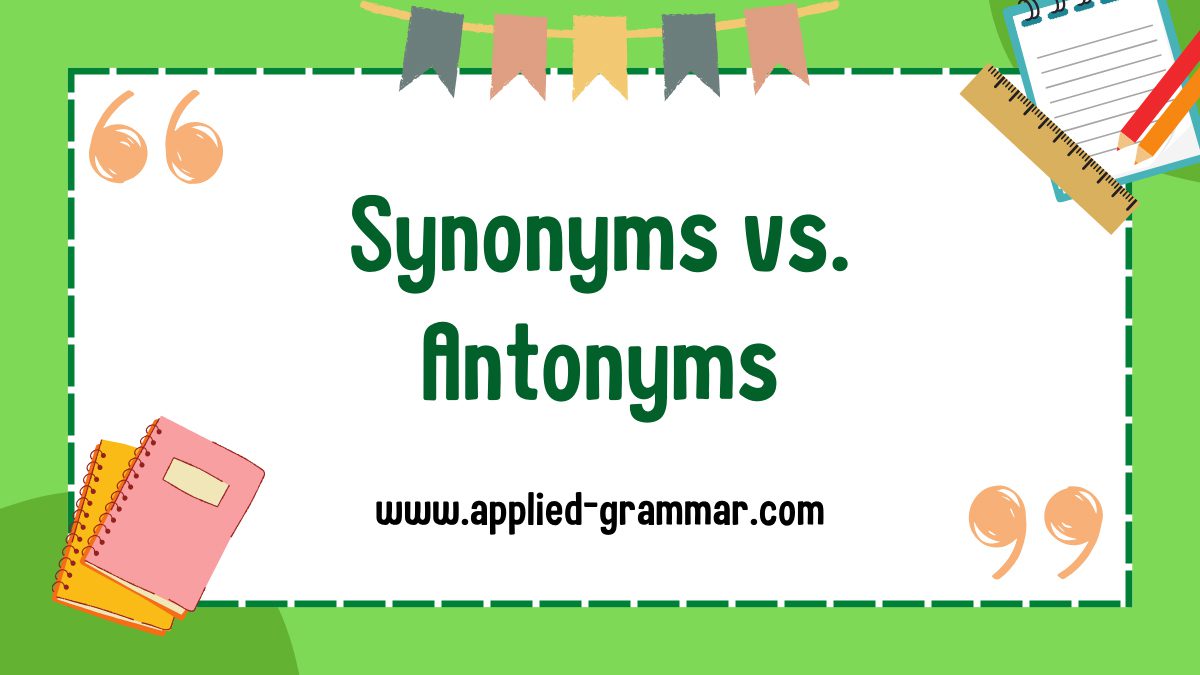Are you curious about the subtle nuances between synonyms and antonyms? In this text, we will investigate into the world of words and explore the fascinating differences between these two important linguistic concepts. Synonyms and antonyms play a crucial role in our language, allowing us to express ourselves with precision and clarity. Understanding their distinctions can enhance your communication skills and elevate your writing to new heights.
Synonyms are words that share similar meanings, providing us with alternative options to convey our thoughts effectively. They offer versatility and richness to our language, allowing us to choose the perfect word to capture the essence of what we want to express. On the other hand, antonyms are words that have opposite meanings, providing a contrasting perspective. They help us create emphasis, highlight differences, and add depth to our writing. By exploring the differences between synonyms and antonyms, you can expand your vocabulary and become a more skilled communicator. So, let’s begin on this journey of words and discover the power of synonyms and antonyms.
Key Takeaways
- Synonyms are words or phrases that have similar meanings, providing alternative options for expressing thoughts effectively.
- Antonyms are words that have opposite meanings, providing contrast and differentiation in language.
- Synonyms offer variety, richness, and precision to language usage, while antonyms emphasize differences and highlight contrasting ideas.
- Using synonyms can help you avoid repetition, expand your vocabulary, and add flair and style to your writing.
- Antonyms enhance clarity, add depth, create contrast, and expand your vocabulary.
- Understanding the key differences between synonyms and antonyms can enhance your communication skills and elevate your writing.
What are Synonyms?

Definition of Synonyms
Synonyms are words or phrases that have similar meanings. They provide alternative options for expressing thoughts effectively. When you use a synonym, you are essentially saying the same thing, but with a slight variation in the choice of words. Synonyms help add variety and richness to language, making it more vibrant and engaging.
Here are a few key points to understand about synonyms:
- Synonyms have the same or similar meanings.
- They allow you to express your ideas in different ways.
- They provide alternative words that can evoke different emotions or convey different shades of meaning.
Examples of Synonyms
To illustrate this concept further, let’s look at some examples of synonyms:
- Happy, joyful, glad: These words all express a positive and cheerful feeling.
- Fast, swift, quick, rapid: These words all describe a high speed or quickness.
- Small, tiny, little, pintsized: These words all refer to something being of a small size.
Using synonyms can enhance your communication skills and elevate your writing. They help you avoid repetition and add depth to your expressions. By using synonyms, you can convey your message more effectively and engage your readers.
Remember, synonyms may have slight differences in connotation or usage, so it’s important to choose the right synonym for the context you are using it in.
What are Antonyms?

Definition of Antonyms
Antonyms are words that have opposite meanings. They provide contrast and differentiation in language. While synonyms have similar meanings and can enhance variety and richness of language, antonyms serve the purpose of expressing opposites.
Here are a few examples of antonyms:
- Pretty and ugly
- Good and bad
- Fast and slow
- Big and small
- Hot and cold
Antonyms can be found in various parts of speech, such as adjectives, adverbs, nouns, prepositions, or verbs. They are pairs of words that have opposite meanings and can add depth and precision to your writing.
- Complementary antonyms: These antonyms are completely opposite from each other and have no middle ground. They form binary oppositions. Here are some examples:
- True and false
- Empty and full
- Open and closed
- Dead and alive
- Pass and fail
- Relational antonyms (converse antonyms): These antonyms are words that are related to each other in some way but cannot exist without one another. They represent opposite ends of a spectrum or a relationship. Examples include:
- Parent and child: You can’t be a parent without having a child, and all children must have a parent.
- Buy and sell: To sell something, there needs to be a buyer, and vice versa.
- Graded antonyms: These antonyms are words that are opposite from each other but are used to describe qualities. They represent degrees on a scale. Some examples include:
- Light and heavy
- Short and tall
- Near and far
- Hot and cold
Understanding antonyms can help you add nuance and precision to your writing by effectively expressing contrast and differentiation. Using antonyms can elevate the impact of your language and make your writing more engaging.
In the next section, we will explore the purpose and benefits of using antonyms in your daily language.
Key Differences between Synonyms and Antonyms

Meaning
Synonyms and antonyms are two distinct types of word relationships that play important roles in language and communication.
Synonyms are words or phrases that have similar meanings. They serve as alternative options for expressing thoughts effectively. Using synonyms in writing and speech can enhance communication skills by adding variety and richness to language. For example, instead of always using the word “good,” you can choose synonyms like “excellent,” “superb,” or “outstanding” to convey a similar meaning while adding depth to your writing.
Antonyms, on the other hand, are words that have opposite meanings. They provide contrast and differentiation in language, allowing writers to effectively express opposing concepts. Antonyms can add depth and precision to writing. For instance, using antonyms like “hot” and “cold,” or “big” and “small,” can help convey the exact opposite meanings and create a more vivid picture in the reader’s mind.
Usage
Synonyms and antonyms have different applications in language usage.
Synonyms are particularly useful when you want to avoid repetition in your writing and speech. They help you to expand your vocabulary and introduce variety to your communication. Using synonyms allows you to express yourself more precisely and creatively.
On the other hand, antonyms are helpful when you want to express contrast or provide differentiation in your writing. They allow you to convey opposing ideas or compare two different concepts. Antonyms can add depth and complexity to your writing by highlighting the differences between words.
Behavior in Context
Synonyms and antonyms have distinct behaviors when used in different contexts.
Synonyms provide flexibility in language usage, allowing you to choose words that suit the context and convey your intended meaning. The use of synonyms can make your writing more engaging and interesting, as it adds variety and richness to your language.
Antonyms, on the other hand, emphasize differences and contrast in language. They help you clearly define and express opposing ideas. Using antonyms can make your writing more dynamic and impactful by highlighting the distinctions between words or concepts.
Summarizing, synonyms and antonyms have different meanings, purposes, and behaviors in language usage. Synonyms provide alternative options for expressing similar meanings, while antonyms offer contrast and differentiation. Both types of word relationships can enhance your writing and communication skills by adding variety, richness, and precision to your language. By understanding the key differences between synonyms and antonyms, you can effectively use them to elevate your writing and express your ideas more effectively.
When to Use Synonyms?

Advantages of Using Synonyms
Using synonyms in your writing can bring several advantages. Here are a few reasons why incorporating synonyms into your writing can be beneficial:
- Avoiding Repetition: Synonyms allow you to avoid using the same word over and over again. By using different words with similar meanings, you can add variety and richness to your writing. For example, instead of repeatedly using the word “happy,” you can use synonyms like “joyful,” “delighted,” or “content” to convey similar feelings while keeping your writing fresh.
- Expanding Vocabulary: Using synonyms provides an opportunity to expand your vocabulary and explore different shades of meaning. It allows you to express yourself with precision and choose the most appropriate word for the context. By incorporating synonyms into your writing, you can enhance your communication skills and effectively convey your thoughts.
- Adding Flair and Style: Synonyms can bring a touch of creativity and style to your writing. By choosing synonyms with more specific connotations or imagery, you can add depth and nuance to your language. This can make your writing more engaging and captivating for your readers.
Examples of Using Synonyms
Let’s take a look at some examples of using synonyms in different contexts:
- Emotions: Instead of using the same word to describe a particular emotion, you can use synonyms to add variety and express different shades of that emotion. For instance:
- Instead of saying “I’m sad,” you could say “I’m feeling melancholy” or “I’m feeling sorrowful.”
- Instead of saying “He’s smart,” you could say “He’s intelligent,” “He’s clever,” or “He’s brilliant.”
- Sizes and Quantities: When describing sizes or quantities, using synonyms can offer different perspectives and emphasize specific aspects. For example:
- Instead of saying “It’s big,” you could say “It’s enormous,” “It’s gigantic,” or “It’s massive.”
- Instead of saying “It’s small,” you could say “It’s tiny,” “It’s petite,” or “It’s minuscule.”
- Actions: Synonyms can add variety to action-related words and make your writing more dynamic. For example:
- Instead of saying “We began the project,” you could say “We initiated the project” or “We started the project.”
- Instead of saying “They ended the event,” you could say “They concluded the event” or “They finished the event.”
Incorporating synonyms into your writing can elevate the quality and impact of your content. Remember to choose synonyms that align with your intended meaning and enhance the clarity and effectiveness of your message.
When to Use Antonyms?
Antonyms, or words with opposite meanings, can be a powerful tool in your writing arsenal. Whether you’re a student looking to expand your vocabulary or a writer aiming to add depth and variety to your content, understanding when and how to use antonyms can greatly enhance the effectiveness of your writing. In this section, we will explore the advantages of using antonyms and provide examples of their usage to help you master the art of incorporating antonyms into your writing.

Advantages of Using Antonyms
Using antonyms in your writing offers a range of benefits, including:
- Enhancing Clarity: Antonyms help to highlight the differences between contrasting ideas or concepts, making your writing more clear and precise.
- Adding Depth: By incorporating antonyms, you can bring depth and complexity to your writing, allowing your readers to engage with multiple perspectives on a given topic.
- Creating Contrast: Antonyms allow you to create contrast and emphasize differences, making your ideas more impactful and memorable.
- Expanding Vocabulary: Using antonyms in your writing is a great way to expand your vocabulary and demonstrate a strong command of language. It enables you to express yourself more precisely and creatively.
Examples of Using Antonyms
Let’s take a look at some examples of how antonyms can be effectively used in different contexts:
- Emotions: Using antonyms can help convey contrasting emotions and feelings. For example:
- She was filled with joy when she saw her test results, while his face reflected disappointment.
- Sizes and Quantities: Antonyms can be used to compare and contrast sizes or quantities. For instance:
- The enormous skyscraper towered over the tiny houses below.
- Actions: Antonyms can be used to describe contrasting actions or behaviors. For instance:
- He entered the room quietly, while she stormed in, making a grand entrance.
- Qualities: Antonyms enable you to illustrate opposing qualities or characteristics. For example:
- The painting was a beautiful blend of light and dark, capturing the artist’s contrasting emotions.
By incorporating antonyms into your writing in these ways, you’ll be able to add depth, clarity, and impact to your content.
Conclusion
By exploring the difference between synonyms and antonyms, you now have a deeper understanding of how these linguistic tools can enhance your writing. Synonyms offer variety and help you avoid repetition, making your content more engaging and dynamic. On the other hand, antonyms introduce contrast and clarity, allowing you to convey complex ideas with precision.
Incorporating antonyms into your writing can add depth and impact to your content. By using words with opposite meanings, you create a sense of tension and highlight the nuances of your message. This can be particularly effective when discussing emotions, sizes and quantities, actions, and qualities.
Remember, both synonyms and antonyms have their place in your writing toolkit. Utilizing a combination of both will enable you to craft compelling and nuanced content that captivates your readers. So, whether you’re aiming to add variety or create contrast, don’t hesitate to explore the vast world of synonyms and antonyms to elevate your writing to new heights.
